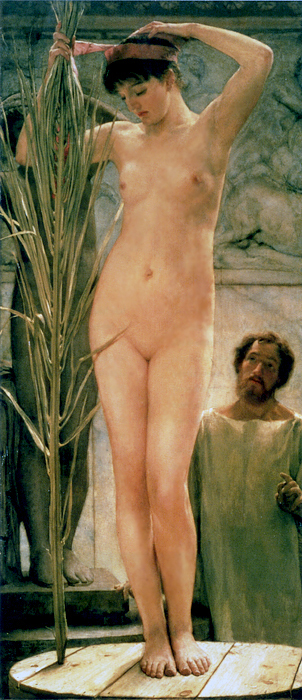
"My mind has been considerably exercised this season by the exhibition of Alma-Tadema's nude Venus....for a living artist to exhibit a life-size, life-like, almost photographic representation of a beautiful naked woman strikes my inartistic mind as somewhat, if not very, mischievous."
Bishop of Carlisle
A Sculptor's Model was commissioned by the father of the painter John Collier as an academic life study. Painted by Lawrence Alma-Tadema in 1877 and exhibited the next year in Liverpool, it also was an attempt to recreate the posture of the Esquiline Venus, which had been excavated in 1874 and seen by the artist on a visit to Rome the following year. (The statue is hidden behind the palm frond that supports the model's arm).
But the classical pretext did not sufficiently distant the subject from its the audience. The naked model becomes the subject of the sculptor's gaze (as it is of the viewer), rather than the ideal represented by her form. To critics at the time, this undue emphasis on the model allowed her to be seen as just that, a nude and not a Venus, simultaneously both realistic and artificial. The impression is reinforced by the platform on which she stands and the prop to hold her position, which also were used in contemporary life study classes.
A retort to the Bishop of Carlisle is conveyed in letter to The Builder (May 23, 1885), written in response to a British Matron, who is described there as "a vulgar-minded idiot."
"The writer would have done well to remember the rebuke once administered to a lady of similar prejudices, who observed to the company who were looking at a picture, that 'it was a very indelicate picture,' and was met by the comment that 'the indelicacy was in the remark.'"
"Life-size" indeed: the picture is more than six-feet tall.
Reference: The Victorian Nude: Sexuality, Morality, and Art (1996) by Alison Smith.